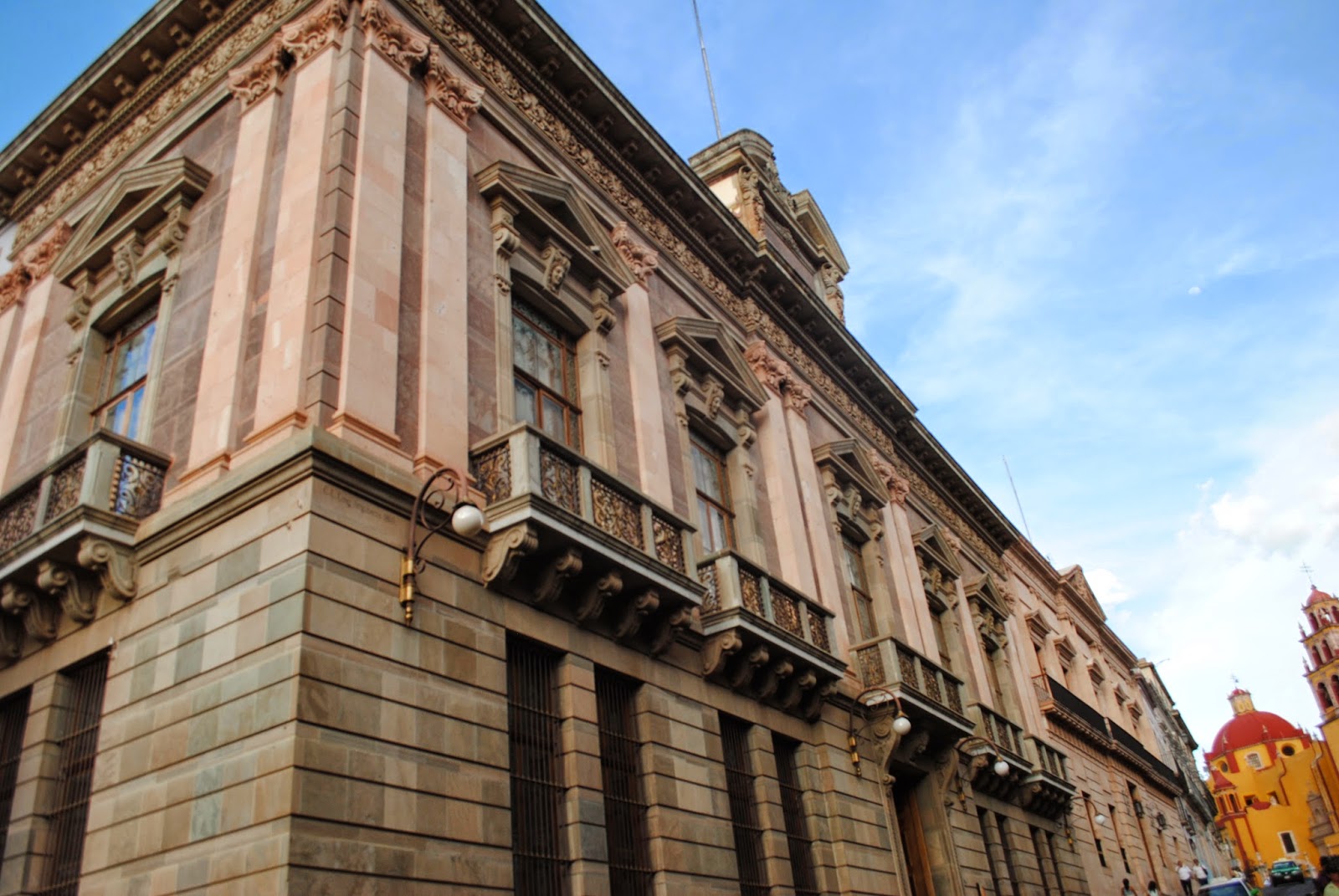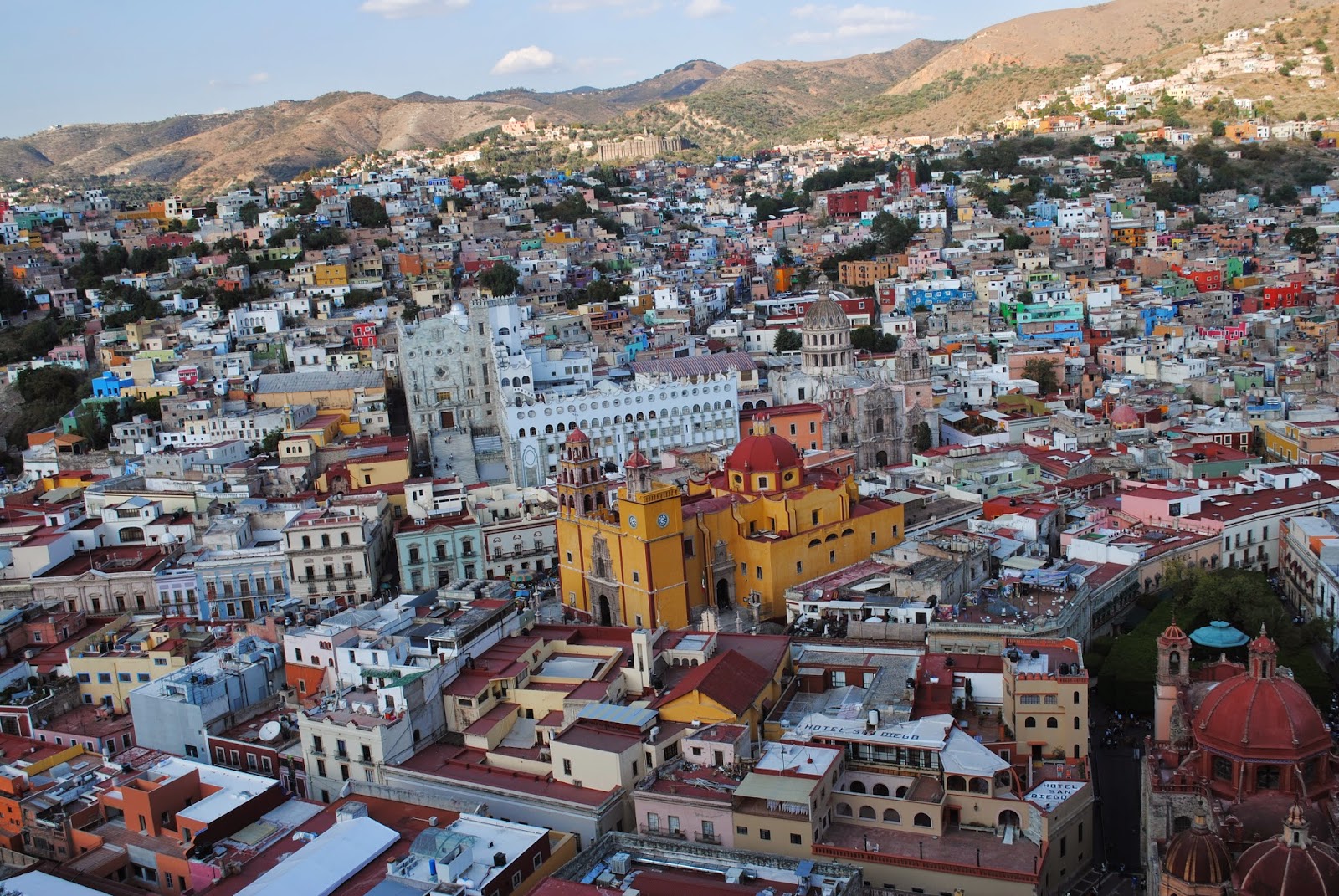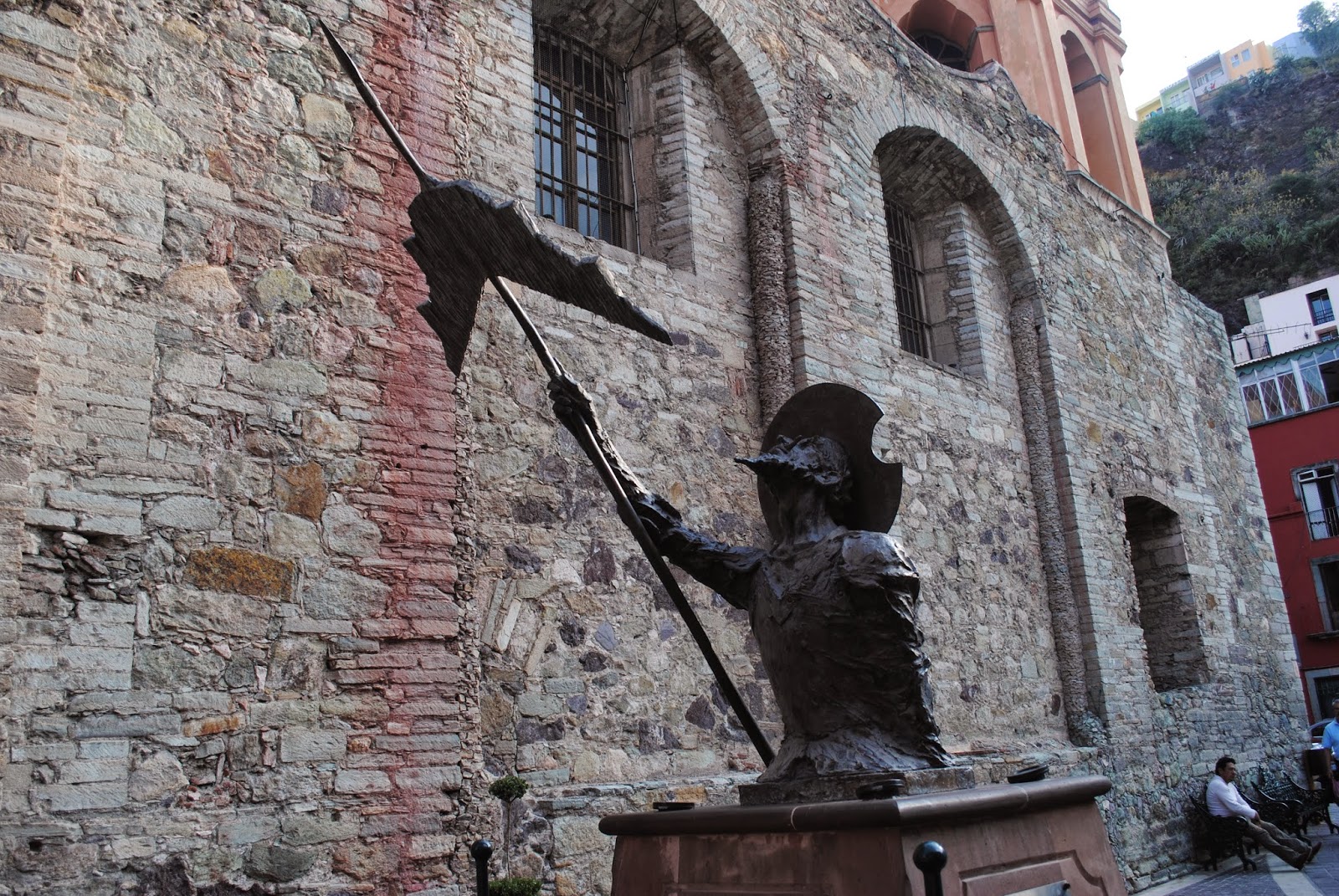A return to the past, a city that invites you to use the imagination, and it makes you wonder how it was four hundred years ago, when it had its peak by the explotation of gold and silver mines, in every street, tunnel, alley or legend, you may breathe the essence of that era.
The city of Guanajuato is located in the mexican bajio, 360 km away from the capital city, you have to drive through the 45 highway.
Guanajuato means in the old nahuatl language "hilly place of frogs", the first settlements were by the tribes of the Otomies, the city itself was founded in 1546 by the order of the viceroy Antonio de Mendoza, as Real de Minas of Guanajuato.
Now, let's take a walk around this place, the first spot it's the square of the peace and the Basilica of our lady of peace, a building that still keeps on their fronts mannerist baroque elements, it's construction was completed in 1696.
The main square or square of the peace is seated on uneven terrain, sloping triangle-shaped, it was builded in 1865, in it's center is the statue of the peace, was unveiled by Porfirio Diaz in 1903.
We continue walking down that street, one block ahead is the second spot, just in front of the union garden, there is the Juarez Theater, builded at the end of the XIX century, the facade is made of twelve green granite columns, topped with bronze, on top of which include eight of the nine muses.
this street will lead us to another temple, the temple of Saint Francisco, that was builded in 1792.
we turned to the left into this maze, and the first building is the Main Theatre, considered as one of the best in the country, these days this theatre is managed by the University of Guanajuato, they has held shows of contemporary dance
Next to this theatre is the Baratillo square, an old market, the main characteristic of this square, is it's fountain, a column that supports a big shell, decorated by dolphins.
a couple of blocks ahead is the Gallery of the temple of the company, builded in 1765, now it has pictures of three different styles, tequitqui, baroque, and neo-classic, many paintings belong to the XVII century.
This city has a lot to show! Guanajuato plays a very important roll in the Mexican history, the foundations of the mexican independence began right here!! and also was designated as world heritage by the UNESCO.
let's continue through the streets of this maze, just next to this gallery is the University of Guanajuato, one of the main symbols of this city, a building from 1732, originally was an hospice and later a college.
trough the same street we arrived to the Guanajuato's museum, a building from the XVII century, this building belonged to the Marquis of Rayas, it has a collection of pieces from the XVIII and XIX century.
the traveler should take it's time to walk without hurry, to enjoy the alleys and the tunnels of this city, near the main square, you may find people who offers the traditional "callejoneada", that is a walk through the alleys of this city, along with the "estudiantina" a group of musicians, dressed up like the colonial times, singing and telling the stories of the city
we turned to the left and we are back to the same place where we started, on this street is the town hall of Guanajuato, it was open by Porfirio Diáz in 1903.
two blocks ahead from this point is the Angels square, a few steps ahead you will find the alley of the kiss, at some point the narrowness of this alley becomes 68 centimeters, the balconies of both houses, almost touches each other, and it's in this place where a legend is born.
The story tells about two lovers, Don Carlos and Doña Ana, separated by the orders of the father of Ana, a violent and greedy man, the lovers were forced to fight against the wishes of that man, with ideas of wealth and power, who wanted to send his daughter to Spain, to marry a rich man, Ana and her nanny decides to buy the opposite house, where one of the balconies, reaches the window of the bedroom of Ana, the lovers agree, to be in that place, until one day, Ana's father discover them, blinded by the anger, stabbed his daughter to death, Carlos, beholding the whole scene, he just kissed the dead skin of her woman.
The tradition is, if you visited this place, you should kiss your girlfriend on the third step of the alley, in order to have seven years of happiness!!.
Now it's time to prove our physical condition, we return to the street that lead us to the Juarez theater, we will walk all the way up to the statue of El Pipila, on the way, we crossed to the passageway Alexander Von Humboldt.
we started to climb the thousand of steps, to reach the top of the hill, where it lays, the statue of the Pipila, this character, mythical, we are not certain that existed, played an important role, in the history of the war of independence, when the army of the priest Miguel Hidalgo, opted to attack the Alhondiga of Granaditas, the story says that on september 28 of 1810, after hours of fight, trying to reach the door of this grain warehouse, decided to sent one of his men, in order to set fire to the door, and get in, the name of this man was Juan José de los Reyes Martinez, a.k.a as "el Pipila", who was a miner, the nickname came, because of the similarity of his laughter to the squawk of the turkey, this animal is also known in Mexico, like Pipila, this miner knew very well this warehouse, so he placed a large slab on his back, to protect him from the gunpowder, and with a torch,he crawled all the way to the door, mission that took two hours, when he set fire to the door, the army finally reached the warehouse and Hidalgo succeed.
in this place there is a gazebo, where you may have a magnificent view of the city,
well, not just of the city, but the temple of Saint Diego of Alcantara as well. builded in 1663, was the first monastery of the city of Guanajuato.
it's time to descend, but don't worry, if you are tired, there is a cableway, that takes you all the way down, inside the station of the cableway, you may find the house of the legend of Guanajuato, a small museum that shows with light effects and mannequins, the legends of the city.
You may find a few statues of Don Quijote, and it's because this city held a festival in honour to Miguel de Cervantes, during the month of october, "the Cervantino festival", during this month you may find several cultural events, jazz concerts, experimental theatre, etc. this city also has a museum just for the Quijote!!
If we move to the east side, we find the Saint Roque square, and it's in this very place, where the Cervantino Festival began, this square was builded in 1952, in the middle it rises a cross, guarded by six lamps, as an imitation of the cross of Cordoba in Spain.
If you want to eat or have a drink, are several bars and restaurants next this square.
This street leads you to the Reforma Garden, a place where most of the local people takes a break in the evening.
beside the garden is the parish church of Bethlehem, and old hospital and convent from 1773, with a baroque churrigueresco facade
just across the street, there is another building from the Porfirian era, the Hidalgo Market, was builded over the old bull fighting arena, inside you may buy, traditional garments and mexican candies.
It's time to see the place where the Pipila performed his feat, the Alhondiga of Granaditas, this neoclassical building had many uses, as warehouse, tobacco factory, and jail, until the middle of the XX century, when the Guanajuato government decide to uses it as a museum
now, we're heading to creepy place, one of the most important spots in the city of Guanajuato, the mummy museum, the characteristics of the calcareous soil, highly hygroscopic, and temperature, allows dehydration of the tissues, causing this particular phenomenon, this graveyard was builded in 1853, the first mummy was that of the French doctor Remigio Leroy, buried in 1865, outside this museum you may buy candies with the shape of a mummy.
we started to climb the thousand of steps, to reach the top of the hill, where it lays, the statue of the Pipila, this character, mythical, we are not certain that existed, played an important role, in the history of the war of independence, when the army of the priest Miguel Hidalgo, opted to attack the Alhondiga of Granaditas, the story says that on september 28 of 1810, after hours of fight, trying to reach the door of this grain warehouse, decided to sent one of his men, in order to set fire to the door, and get in, the name of this man was Juan José de los Reyes Martinez, a.k.a as "el Pipila", who was a miner, the nickname came, because of the similarity of his laughter to the squawk of the turkey, this animal is also known in Mexico, like Pipila, this miner knew very well this warehouse, so he placed a large slab on his back, to protect him from the gunpowder, and with a torch,he crawled all the way to the door, mission that took two hours, when he set fire to the door, the army finally reached the warehouse and Hidalgo succeed.
in this place there is a gazebo, where you may have a magnificent view of the city,
well, not just of the city, but the temple of Saint Diego of Alcantara as well. builded in 1663, was the first monastery of the city of Guanajuato.
it's time to descend, but don't worry, if you are tired, there is a cableway, that takes you all the way down, inside the station of the cableway, you may find the house of the legend of Guanajuato, a small museum that shows with light effects and mannequins, the legends of the city.
You may find a few statues of Don Quijote, and it's because this city held a festival in honour to Miguel de Cervantes, during the month of october, "the Cervantino festival", during this month you may find several cultural events, jazz concerts, experimental theatre, etc. this city also has a museum just for the Quijote!!
If we move to the east side, we find the Saint Roque square, and it's in this very place, where the Cervantino Festival began, this square was builded in 1952, in the middle it rises a cross, guarded by six lamps, as an imitation of the cross of Cordoba in Spain.
If you want to eat or have a drink, are several bars and restaurants next this square.
This street leads you to the Reforma Garden, a place where most of the local people takes a break in the evening.
beside the garden is the parish church of Bethlehem, and old hospital and convent from 1773, with a baroque churrigueresco facade
just across the street, there is another building from the Porfirian era, the Hidalgo Market, was builded over the old bull fighting arena, inside you may buy, traditional garments and mexican candies.
It's time to see the place where the Pipila performed his feat, the Alhondiga of Granaditas, this neoclassical building had many uses, as warehouse, tobacco factory, and jail, until the middle of the XX century, when the Guanajuato government decide to uses it as a museum
now, we're heading to creepy place, one of the most important spots in the city of Guanajuato, the mummy museum, the characteristics of the calcareous soil, highly hygroscopic, and temperature, allows dehydration of the tissues, causing this particular phenomenon, this graveyard was builded in 1853, the first mummy was that of the French doctor Remigio Leroy, buried in 1865, outside this museum you may buy candies with the shape of a mummy.
taking the panoramic road from the Mummy Museum, got to our last point of the route, the Valenciana mine and it's church.
Now, I have to continue down the road for the Guanajuato highways!!
Thanks!!!





































































.JPG)


